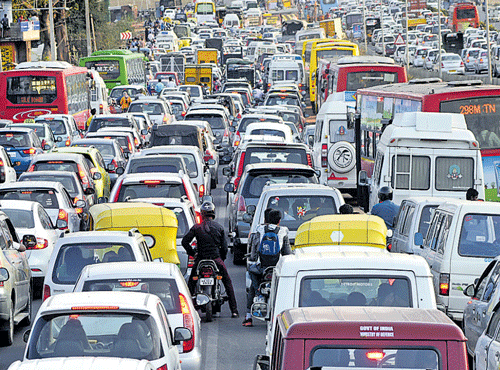
Open Streets: Two buzzwords to rid roads of motorised private vehicles for a day, boosting public transport and freeing up space for walkers and cyclists. For motorists trapped hopelessly in chaotic traffic gridlocks, the concept might sound Utopian; yet, worth a try.
But today, as the city’s HSR Layout residents line up for a dramatic ‘Car-Free Day’ trial, a big question lingers long: Can the concept be scaled up, can it spark a new interest in public transport as a viable alternative to private vehicles? Is the idea potent enough to trigger a workable, multi-modal transport integration that decongests Bengaluru roads and guarantees seamless commute?
The response from policy experts and urban mobility watchers is a disappointed “No!” It can’t be anything else when BMTC, the backbone of Bengaluru’s public transport architecture; the Metro, the Railways and the taxi / autorickshaw ecosystem work in isolation.
The argument, simple and straightforward, is this: Unless people find it easy to switch from one public transport mode to another, the use of personal vehicles will not subside. Inevitably, the City’s five main Regional Transport Offices (RTOs) will continue to register a mindboggling 1,050 private vehicles every day!
Multi-agency
For Sunday’s HSR Layout intiative, multiple government agencies -- Directorate of Urban Land Transport (DULT), BMTC, Bangalore Traffic Police – besides local citizen groups have been brought onboard. But the government strangely skips this strategy as it fails to stitch together a multi-modal mobility network for all Bengalureans.
The loopholes are screaming to be counted: Most Metro stations have no space for BMTC buses to halt, leaving commuters looking for connectivity totally at a loss. The Yeshwantpur railway station and Metro station, barely a few hundred metres away, remain unlinked. There is not even a bridge!
A suburban commuter rail system, a sure-shot way of decongesting the city centre, remains a pipedream. Autorickshaws, an ideal last-mile connectivity option, are notoriously unregulated. Taxi aggregators Ola and Uber offered hope, but commuters are now trapped in steep surge-pricing that could get as expensive as 300 per cent.
The Open Streets campaign is only the latest in a series of similar initiatives experimented in the past. But without addressing the critical connectivity and integration issues, projects such as the ‘Bus Day’ and ‘Cycle Day’ have met with only limited success.
Walkability factor
Walkability, the seamless access for pedestrians to cross between different modes, is equally key to integration. But, as mobility expert, Sanjeev Dyamannavar points out, most city transport projects fail miserably on this front. He notes: “The poorly planned and located sky-walks are one instance. Besides, why can’t we have foot overbridges linking metro stations, bus stops, TTMCs and railway stations?”
In Majestic, the epicenter of Bengaluru’s multi-mode transport ecosystem, commuters are often trapped in unbearably long traffic gridlocks on all approach roads during weekends. From the Gandhinagar side, pedestrians could actually walk up to the bus, railway, metro stations if the conditions were ideal.
‘Ideal’ would mean smooth footpaths to help pedestrians lug their baggage on wheels, skywalks with escalators leading to the foot overbridge at the Subhashnagar bus stand, and a redesigned subway to the railway station. However, as Dyamannavar observes, without a holistic approach, this would hardly work.
It is obvious then that the Bengalurean’s fixation with private vehicles is directly linked to a lack of a networked public transport system. So if integration takes time from the government side, does coercion work on the public?
Does coercion work?
Hefty parking fees and congestion tax for vehicles entering the Central Business District (CBD) are potential measures often talked about. To push commuters on to the Metro, some policy experts suggest steep parking fees along the Metro rail corridors. “Provide ample parking but make it costly” is one advice.
But the old argument about a single CBD has lost its relevance. Bengaluru’s growth patterns have spurred the emergence of multiple CBDs.
This is precisely why BMTC would need to drastically rethink its routes, modelled on long-dead notions of high density areas. Commuters now find it extremely cumbersome to travel even small distances due to paucity of direct buses between the new growth centres.
For BMTC, route allocation is also decided by the availability of roads wide enough to allow buses to such areas.
Traffic expert M N Sreehari points out that almost 60 per cent of Bengaluru roads are too narrow to accommodate buses. This directly impacts frequency of buses, eventually persuading commuters to go for personal transport.
“Many people are in no mood to walk that last mile in their rush to reach their workplaces,” notes Sreehari.
Smaller shuttle buses could be an option on narrow roads. But to beckon office-goers, particularly from the IT sector, Sreehari suggests Wi-Fi enabled buses. “Commuters, equipped as they are with laptops and other mobile devices, could then start their work on the move.”